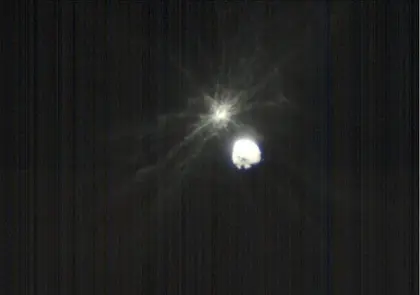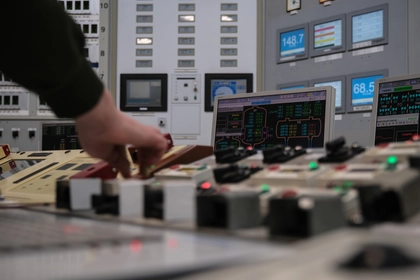A week that included NASA’s efforts to prevent human extinction caused by an asteroid collision and Russia’s threat of the use of nuclear weapons reminds us that we teeter between a superlative future and calamity.
Sometimes in history, events take on strange coincidences that highlight the profound precarity of our civilization, occurrences that are distant from each other and yet oddly resonant.
JOIN US ON TELEGRAM
Follow our coverage of the war on the @Kyivpost_official.
Last week, the American Space Agency NASA slammed a small spacecraft into an asteroid to try to nudge it just a tiny amount, enough to detect that change. Look back 66 million years and you’ll find out why they wanted to do this. About three-quarters of all animals on Earth, including most of the dinosaurs (the birds, descendants of these creatures, are still with us) became extinct when a 10 kilometer-diameter asteroid intersected with our planet and plunged it into cold and darkness, a planetary-enshrouding cloud kicked up by that rocky invader, which killed the plants and everything that relied upon them. A mere fragment of cosmic dust brought an end to some of the most magnificent creatures that ever walked the Earth.
Luckily, asteroid impacts that can cause a global catastrophe of dinosaur proportions are rare. We think they happen about once every 100 million years. But you’ll understand that this doesn’t tell you when they will happen. There might be one this evening, another next weekend, and then a peaceful lull for many millions of years. So having a plan to divert a rogue rock from hitting Earth seems like a good idea if you want to avoid the fate of the biosphere all those tens of millions of years ago. Hence, we arrived at the clapping, cheering, and fireworks when the little rock Dimorphos became the unsuspecting star of this experiment as NASA’s spacecraft hurtled into it, almost dead center, at well over 20,000 kilometers an hour.

Thinking Out Loud – Where We’re at, What’s at Stake, and What Ronald Would Have Said
In fact, NASA’s mission is quite astonishing because, without getting too hyperbolic, it is the first time in the history of life on Earth that a species has emerged that has the wherewithal to develop a technology to avoid an asteroid catastrophe. It was a momentous instant, pregnant with potential for our civilization, when that little craft disintegrated in a cloud of debris and irregular contorted dust.
But as I sat reading the updates on the mission progress during the weekend before impact, my laptop newsfeed also wearily informed me of Russia’s threat to use atomic weapons.
What an odd juxtaposition. One nation crashing craft into an asteroid to help our civilization avoid extinction, another threatening the extinction of Ukraine.
For me, that laptop screen on that otherwise mundane weekend brought into utter clarity the two choices that our civilization faces. For right there in front of me were the extremes of our future laid bare.
In one future, we work together to face up to the enormous challenges that we, as a species, must address. Some of these problems, such as solving the problem of plastic waste, may not be existential in their scale. However, some of these threats, such as asteroid collision, could well push our civilization over the edge, into extinction.
Yet how remarkable it is that the fruits of geological and astronomical science have revealed the history of Earth, its past extinctions and stresses, knowledge that enables us to understand our possible futures. How enthralling it is that we have developed space programs and a grasp of our astronomical environment that enable us to act on these insights. We can use this prowess to launch spacecraft to test out the means to protect the entire planet from errant space rocks. Here is a vision that should inspire us. Humans thinking and acting together to prove themselves equal to Nature’s most chilling tests, in the process protecting this garden of Eden called Earth and simultaneously setting out on a cosmic journey to explore and settle space.
The other future we can envisage is one where instead of using those rockets to launch craft to asteroids, we instead employ them to lob nuclear warheads at our foes, or just to threaten that outcome. This is a future that is riven with jealousies and conflict, in which our differences transform into antagonisms and, ultimately, the abomination of nuclear conflict.
In response to the recent nuclear threats, I have seen some people rhetorically point out on social media that the U.S. set the precedent. It’s important to remember that in 1945, nuclear weapons were viewed as merely large bombs; there was no sense that these contraptions were categorically different from so-called “conventional” weapons. Our improved physics and our ability to model the effects of these weapons has allowed us to understand the global-scale peril that they represent. In fact, it is something of an irony, in the context of this essay, that the predicted effects of a large-scale exchange of nuclear weapons would be a “nuclear winter”, similar to the “impact winter” that a large asteroid would presage.
And that is the point. We have grown up since 1945. Alongside our knowledge of the devastation of asteroid impacts (it was only in the 1980s that the fate of the dinosaurs was revealed), we have realised that nuclear weapons represent a potential civilization-destroying apotheosis of our destructive capabilities. We can act on these intellectual advances to better ourselves and our condition.
After all, that is the point of science and technology: not only to understand the natural world, but to deepen our comprehension of the implications of our own discoveries and their applications, and with it to mature, especially with respect to technologies with which we imperil our own existence and the rest of the biosphere. Taunting the world with the use of nuclear weapons today is a far more misguided course of action than their use at the end of the Second World War.
It is not that parts of the world have failed to grasp the lessons and reflections of the past decades. We happen to know that Russians don’t want nuclear war because it was brilliant Russian and American scientists, at the height of the Cold War, who worked together to reveal the mechanism of nuclear winter and bring it to the world’s attention.
They realised, in attempting to understand the consequences of their use, that if enough of these weapons were detonated, the dust and smoke lofted into the atmosphere would cool the Earth, shut down sunlight and cause a global agricultural calamity, not to the mention the effects of radioactive poison. The discovery of the full consequence of a nuclear winter was an important impetus to reduce the nuclear stockpile when it became apparent that no side could win a protracted nuclear exchange. Even limited use of these weapons would be devastating and would encourage an escalation to their global use. For good reason, even the tactical use of such weapons has been considered a necessary taboo to protect our civilization.
Last week, we saw a vision of these two futures.
Of course, these futures are not mutually exclusive. A country can threaten nuclear war and have a space program. However, they do represent two sharply contrasting images of human directions and the ends to which we can put our growing scientific and technological capacities.
Personally, I would like to hope that in Russia, leaders and scientists have not lost sight of our progress. The Soviet Union had a space program whose accomplishments are well known; among those strides was the first human being to leave Earth. These are accomplishments worthy of great pride, whatever your personal views on the political ideology in which they were embedded. I think Russia should return to applying that capability to peaceful ends, including defending our planet from our common threats. Using rockets to menace Ukraine and the world with atomic hell is surely a terrible postscript to these achievements.
I would like to live in the world where we, and future generations, are free of the fear of nuclear and impact winters. If we apply the rocket technology that confronts us with the abyss of nuclear winter to develop the defence system that can minimise the chances of an impact winter, we can solve both problems at once. To do that, we first must stop threatening to unleash the former nightmare and learn to work together to realize the latter possibility of a protected world for all humans.
Charles Cockell is Professor of Astrobiology at the University of Edinburgh.
The views expressed in this article are the author’s and not necessarily those of the Kyiv Post.
You can also highlight the text and press Ctrl + Enter






